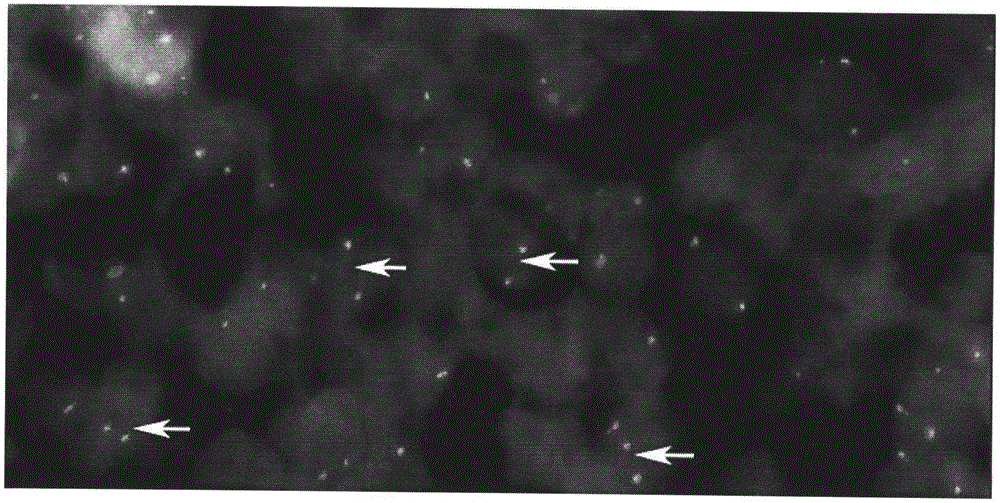Application of fluorescent in-situ hybridization polyclonal separating probe for renal carcinoma and kit thereof
A technique of fluorescence in situ hybridization and polyclonal separation, which is applied in the application field of fluorescence in situ hybridization probes, can solve problems such as being unsuitable for wide application and complex technology, and achieve the effects of optimizing diagnostic methods, strong fluorescent signals, and expanding scope.
- Summary
- Abstract
- Description
- Claims
- Application Information
AI Technical Summary
Problems solved by technology
Method used
Image
Examples
Embodiment 1
[0043] Step 1: Preparation of polyclonal DNA probes:
[0044] Use http: / / genome.ucsc.edu / to search for bacterial artificial chromosomes (BAC clones) corresponding to both sides of the TFE3 gene on the X chromosome (ie, the telomeric side and the centromere side), and select 3 BAC clones of similar size on both sides Fragments, control the farthest distance between the BAC clone fragments on both sides within 1500Kb and do not overlap each other, while the three fragments on the same side have a certain sequence overlap with each other. According to the above requirements, the BAC clone fragments on the telomeric side of TFE3 were selected as CTD-2516D6 (chrX: 48265836-48484403, the fragment length is about 218Kb), CTD-2522M13 (chrX: 48420425-48602847, the fragment length is about 182Kb), RP11-416B14 ( chrX: 48580872-48763198, the fragment length is about 182Kb); TFE3 centromeric BAC clone fragments are CTD-2312C1 (chrX: 48959513-49170367, the fragment length is about 210Kb), ...
Embodiment 2
[0056] Example 2: Xp11.2 Translocation / TFE3 Gene Fusion-Related Kidney Cancer Diagnostic Kit
[0057] Fluorescence in situ hybridization polyclonal separation probe kit for kidney cancer, the kit is composed of probe hybridization liquid and 4', 6-diamidino-2-phenylindole counterstain, characterized in that:
[0058] (1) TFE3 telomeric side BAC clone fragments are a combination of RP11-416B14, CTD-2522M13 and CTD-2516D6, labeled with green fluorescence; TFE3 centromere side BAC clone fragments are CTD-2312C1, CTD-2248C21 and RP11-959H17 combination, labeled red fluorescence.
[0059] (2) The two kinds of polyclonal separation probes were mixed with Human Cot-1 DNA, hybridization buffer, and purified water in proportion to prepare a probe hybridization solution, and stored in a freezer at -20°C in the dark.
[0060] (3) 4′,6-diamidino-2-phenylindole counterstain is mainly used for nuclear DNA staining.
[0061] The fluorescent in situ hybridization polyclonal separation probe...
PUM
 Login to View More
Login to View More Abstract
Description
Claims
Application Information
 Login to View More
Login to View More - R&D
- Intellectual Property
- Life Sciences
- Materials
- Tech Scout
- Unparalleled Data Quality
- Higher Quality Content
- 60% Fewer Hallucinations
Browse by: Latest US Patents, China's latest patents, Technical Efficacy Thesaurus, Application Domain, Technology Topic, Popular Technical Reports.
© 2025 PatSnap. All rights reserved.Legal|Privacy policy|Modern Slavery Act Transparency Statement|Sitemap|About US| Contact US: help@patsnap.com



